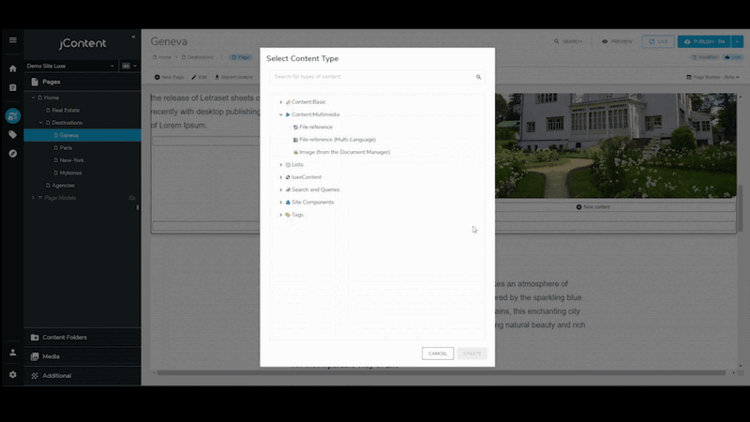User-friendly JavaScript & Java CMS : discover Jahia 8.2

With version 8.2 of Jahia, the CMS and DXP market sees the arrival of a solution designed for both developers and contributors. Jahia 8.2 is not only the first JavaScript CMS, but also the first JavaScript CMS with WYSIWYG content editing.
Javascript CMS: a brief presentation of the innovation
Jahia, historically a Java CMS, is opening up to JavaScript with this new version, in order to make its technology accessible to more developers, and to simplify website creation for businesses.
How do you develop a website with a JavaScript CMS?
We created JavaScript modules to make it possible to build websites with Jahia without any knowledge of Java. These JavaScript modules are based on React/ JSX, and are rendered server-side.
Everything you need to know about JavaScript modules is available in the developer documentation. If you're a developer, you can also request a demo license and follow our new tutorials.
What impact will this have on website development for organizations?
This innovation in website development is designed to improve the developer experience, but also to make it easier for organizations to create their own websites.
Why?
- Because JavaScript is one of the most widely used languages, so resources are easier to find,
- Because it's also one of the easiest languages to learn, enabling organizations to upskill existing staff rather than recruiting new ones,
- Because developing a site with only front-end developers reduces development costs,
- Because it also reduces the number of people working on a website, and therefore development time.
Learn more about the resources required for a Javascript CMS project
New features in the Jahia CMS for contributors
This new version of the Jahia CMS also brings significant improvements to the contribution experience. There are 3 main areas of change:
- Context-sensitive page creation and editing (WYSIWYG),
- Content creation and formatting,
- Category and tag management.
Context-sensitive page creation and editing (WYSIWYG)
In the latest version of Jahia's CMS and DXP, we've worked on a clean, intuitive interface, and added key features for an enhanced editing experience. The result is the Page Builder, a new user interface for managing page content in context-sensitive editing (WYSIWYG).
Page creation is a simple click away, and configuration, such as adding components, is just as intuitive. Adding new elements to a page is comparable to what can be found in traditional consumer CMS, with spaces appearing on mouse-over to suggest integration. Editing options are available with a simple right-click (edit, copy, paste, delete, export, publish).
Page layouts are just as easy to create, with varying degrees of flexibility depending on your needs (page models or templates).
For those who prefer to have an overall view of their page for editing purposes, the interface also comes in a list view, with flat content, and a structured view, with hierarchical content.
Content creation and formatting
Here again, Jahia's new editing interface is in line with the best standards of contribution experience on the market. You'll find, for example, a streamlined text editing window, a simplicity that guarantees a contribution experience devoid of the slow editing and loading caused by some CMS Page Builder plugins.
Contributors can simply insert various components into a page, these components being defined during development to meet their exact requirements.
The component library includes generic elements such as Basic Content (text and rich text), Multimedia Content (image, video, sound, etc.), as well as customized components (sections, columns, tables, etc.).
Category and tag management
Organizing your content using a CMS system of categories and labels saves time in managing content, simplifies website navigation for users, and improves natural search engine optimization.
Categories are hierarchical classifications whose role is to structure content logically and thematically. Tags are another way of organizing content. Tags are descriptive keywords assigned to content.
While categories and tags are widely used to group pages according to theme, their application is much broader. Any piece of content, such as a block that can be reused on your various sites, can, in Jahia, be structured using these functions.


